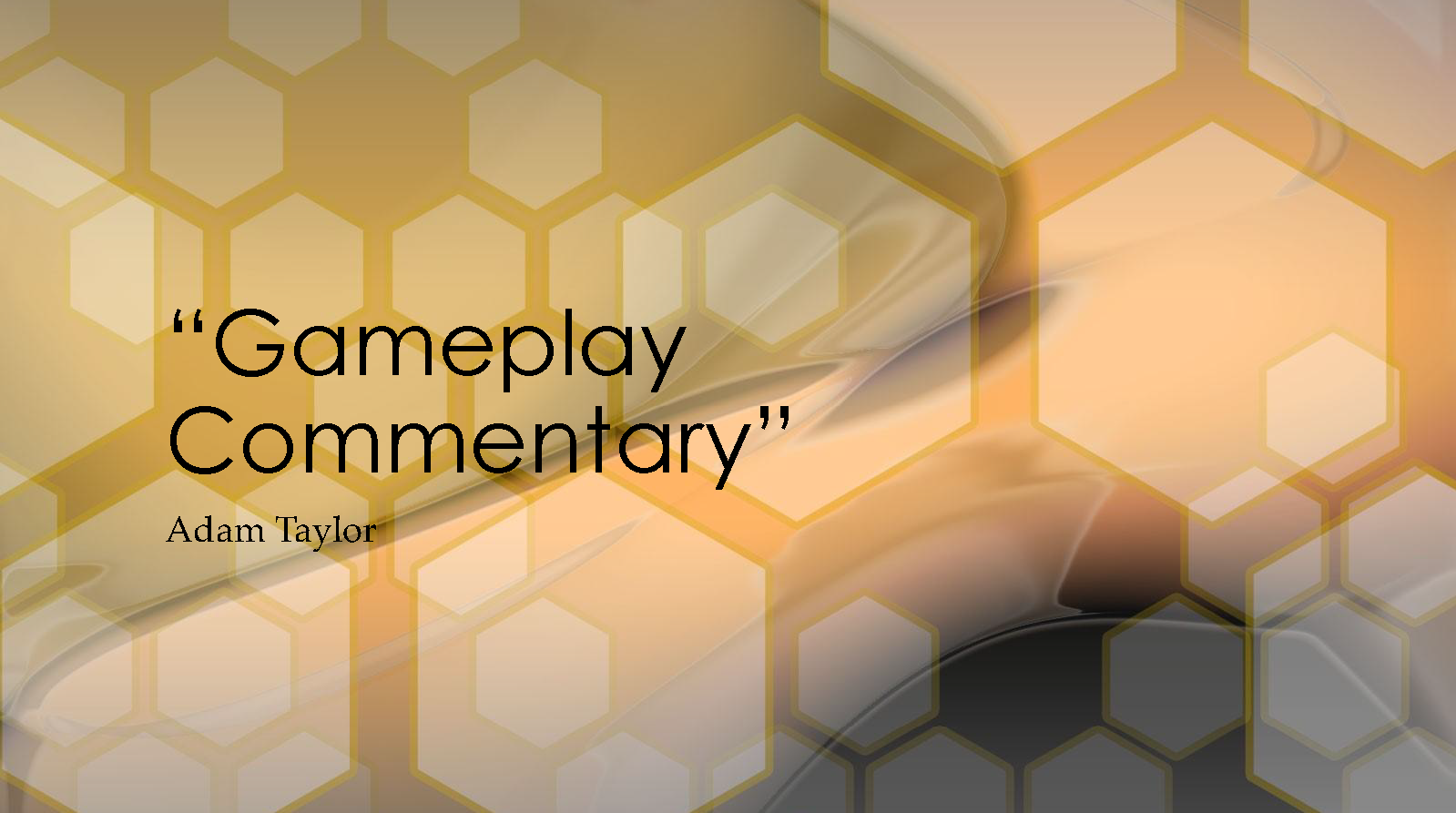[Writer’s note: This was my primary paper for a communications course during my senior year at University in spring 2015. I never sought publication at the time, despite minimal available research on genres and categorization of online-first media at the time, which I regret. I reference this paper in a recent YouTube video and thought it made sense to make sure my paper was published in some form.
Here (using the requirements of my paper at the time) I attempt to carve out a genre of classification for web (mostly YouTube) videos called “Gameplay Commentary.” A lot has changed since 2015, but I still think these conversations were important to have at the time – and perhaps more important now, as things have continued to change and evolve and newer generations don’t always arrive with full context of the landscape prior to the now.
I am uncertain whether these are the final drafts of either document, but I believe they are.
Copy of this paper and copies of the slides also available on Internet Archive.]
Let’s Play Together:
“Gameplay Commentary” As Emerging Genre of Web Video
Adam Taylor
Indiana University Southeast
Let’s Play Together
More than likely, every U.S. resident that has access to the internet has seen a video on YouTube before. YouTube has been on a virtually never-ending path of growth ever since it launched just 10 years ago. But despite its now decade-long age, scholarly discussions regarding the rhetoric of YouTube still seem to be minimum. YouTube is no longer just a place for cat videos and music video re-uploads. Thousands of hours of original content is being uploaded to YouTube every day. Not all of it is worth watching, but there is plenty of quality content available – and the creators of said content have begun to find great success in their work. Subscriber (or follower) counts up in the millions, view totals in the billions – YouTube content creators have a wide reach.
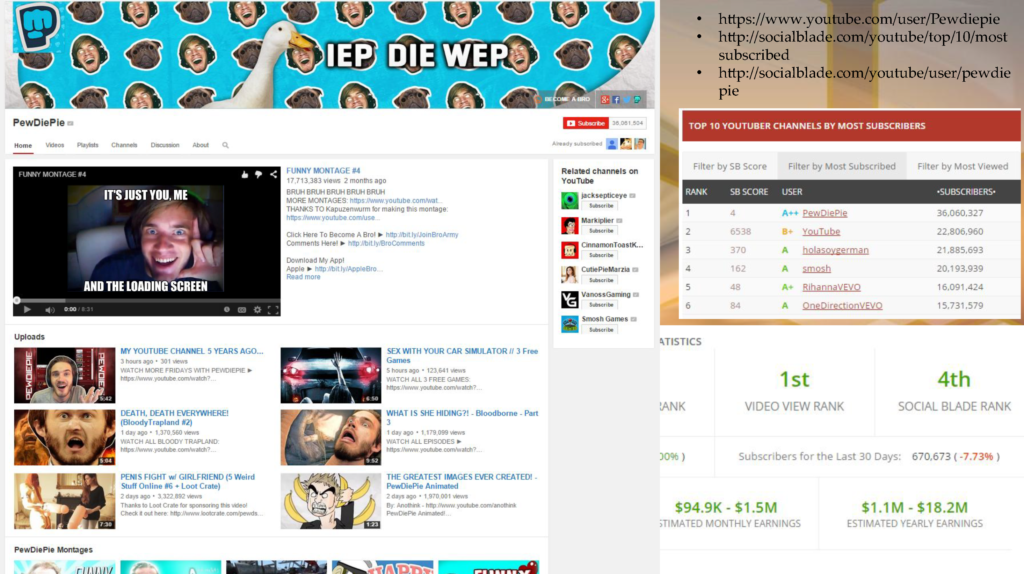
Some of the biggest content creators, or “YouTubers,” actually create content using video games. Formally dubbed “Machinima,” this content uses video and audio assets from video game engines to create videos. These videos can be anything from movie trailer re-enactments to short films to simply provide a way for the creator to talk to their audience and make a connection to them, while having something interesting to show beyond their face. This kind of “gameplay commentary” is what this essay will focus on. The goal of this essay is to show how YouTube content creators (YouTubers) utilize the platform of video games and an interactive connection to their audiences to create their own genre of entertaining rhetoric, a “gameplay commentary” that now serves as a replacement for traditional television shows to those who consume it.
This essay is composed of three parts: In “Hello Everyone, My Name is ____”, the context of the kinds of YouTube videos that make up the genre of “Gameplay Commentary” will be focused on, along with the implications for YouTube scene. In “Upload”, the creation and delivery aspects of videos, as identified in the selected artifacts, will be focused on, as well as how they contribute to a shared genre. In “Subscriber Count”, the focus will be on the connections between the rhetors and the audiences, as well as the understood or expected genre to be derived from the videos and audiences.
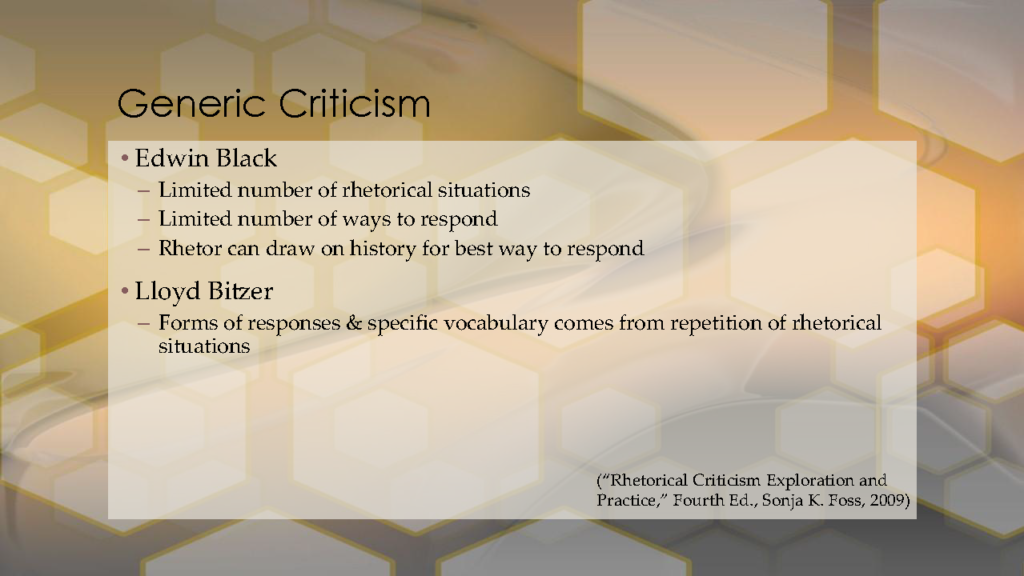
For this essay, various YouTube videos will be analyzed and compared using generic description analysis to identify a common genre among a few pieces of rhetoric. Generic description analysis finds its roots in the ancient Aristotelian days but was not directly established until the 1960s and 1970s. The “‘Significant Form’ in Rhetorical Criticism” conference in 1976 established the idea and basis for the process of identifying a new or abstract genre among rhetorical artifacts by looking for patterns of repeated elements.
Artifacts can exist and be similar to one another without constituting a unique genre. Generic criticism requires there to be specific types of situations to provoke similar needs and expectations within audiences or assumed audiences. Generic description criticism will be used in this essay to look for similarities in rhetorical patterns across recurring situations. The type of situation involved in this essay is the expectation of a YouTube video to be created and uploaded to a YouTube channel with a specific audience.
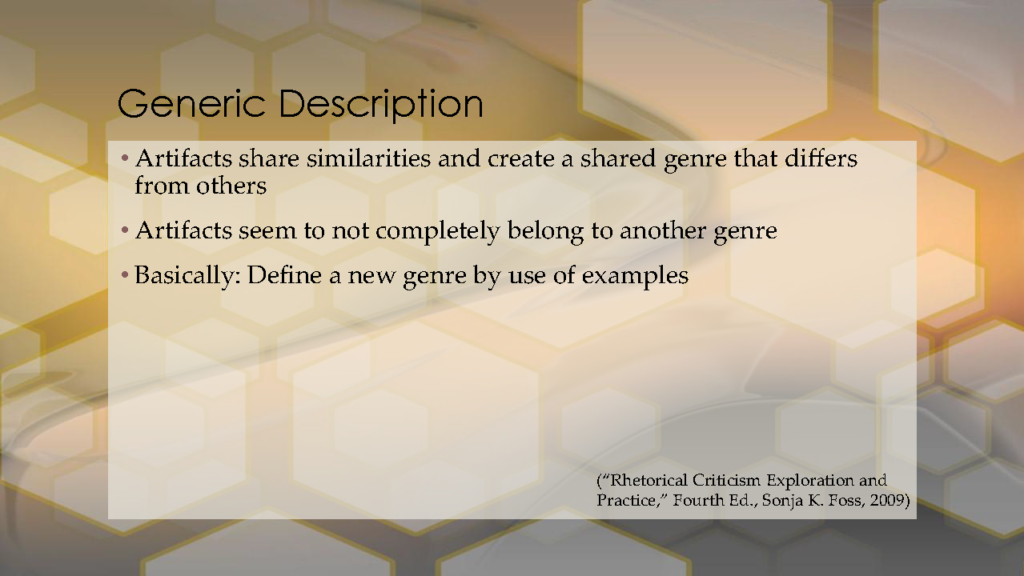
The rhetorical artifacts used for analysis are various YouTube videos relating to video games that were created using similar technologies and techniques to achieve similar purposes.
The 2010 video “Dealing With Stress” by Adam “SeaNanners” Montoya utilizes video footage of the game Call of Duty: Modern Warfare 2 and voice-over recording to discuss the concept of stress with the creator’s audience, while relating it to video games and YouTube culture (SeaNanners Gaming Channel, 2010). SeaNanners’s YouTube channel (at the time) predominantly featured Call of Duty videos with various topics being discussed. He worked at a company called Machinima where he created and produced similar videos for the company.
YouTube user “BBK Dragoon” (who keeps his personal information, such as his real name, private) uses video footage of the game Halo: Reach along with music and voice-over in his video “Monday Night in the Pit | Hayabusa Sniping” to discuss topics relevant to his audience and the audience of the Halo video game franchise (BBKDRAGOON, 2012). “Monday Night in the Pit” is a regular video series that BBK Dragoon has run on his YouTube channel since 2012. His channel has a large Halo following, and at the time most of his videos focused on Halo gameplay.
In “Minecraft :: MY Redstone Tutorial 4U :: Mindcrack Server :: Episode 39,” YouTube user “BdoubleO100” (whose first name is John but keeps his last name private as well) plays the game Minecraft with a friend over the internet (BdoubleO100, 2014). He and his friend, “GenerikB,” provide voice-over discussion via a VOIP (voice over internet protocol – using a service such as Skype, Mumble, or TeamSpeak) call as they play the game (BdoubleO100, 2014). BdoubleO100’s channel primarily consists of Minecraft videos like this one.
The video “Lightning Returns Final Fantasy XIII Walkthrough Part 17 – Vanille (Gameplay Let’s Play)” by YouTube user “Tetra Ninja” features footage from the game Lightning Returns: Final Fantasy XIII along with some voice-over (Tetra Ninja, 2014). This video is a walkthrough, or a guide of sorts, to play through a section of the game. The video is the 17th part of a 34-part series playing through the full game. Tetra Ninja’s channel features full walkthroughs of many different video games.
Finally, the video “#70: I’m on a boat (World of Warcraft with IamChiib)” by YouTube user “Panserchu” (also known as “Panser” or “TradeChat” across her other channels and social media accounts, will be referred to as Panser hereafter) utilizes video footage of the game World of Warcraft, along with a webcam video feed of the creator and voice-over of herself along with her friend “IamChiib” via a VOIP call (Panserchu, 2015). This video (and the multi-part series that it is a part of) relies primarily on talking about the game as they play through it, but also involves the two speakers (Panser and IamChiib) discussing topics they come up with as they play the game or responding to viewer messages that they receive via the in-game messaging system within World of Warcraft (PanserChu, 2015).
Hello Everyone, My Name is ________
A now popular trend of YouTube videos pertaining to video games involves the core visual element being gameplay footage from a video game. This can have various text or graphics overlays on top of it, as well as video of the creator’s face if they’re doing camera work that they want to show as well. The audio portion may have the video game footage’s sound or music playing at a low volume in the background. The main audio is the voice of the video creator. This video can be anywhere from one minute long to hours long, depending on the subject and the creator.
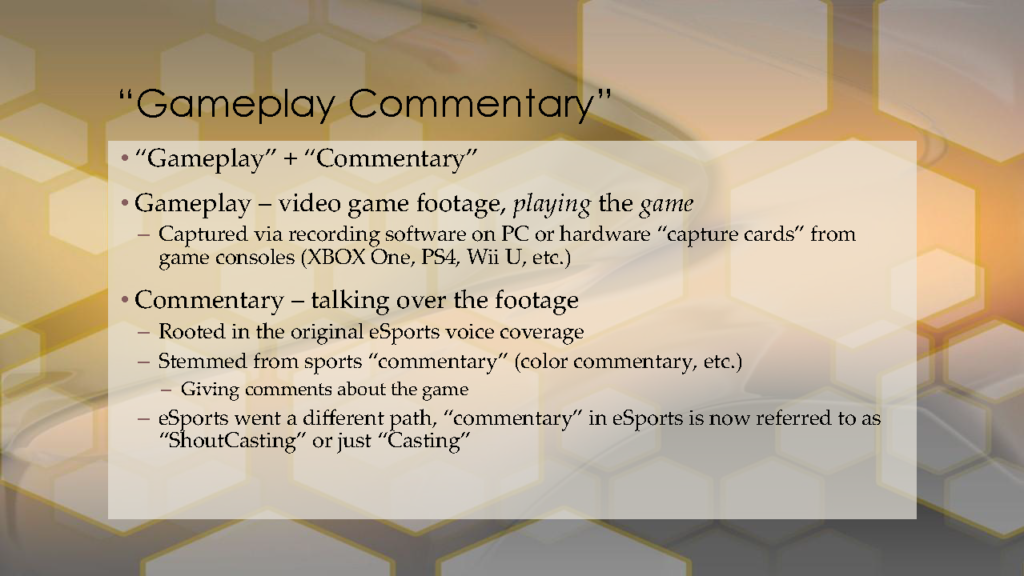
The creator uses the voice-over to talk over the gameplay, or “commentate” as often referred to by the community. The use of the concept of “commentary” here is derived from the idea of sports commentary – live or after the fact – as would be seen during live football or basketball game broadcasts and scheduled programs one might expect from television channels like ESPN. The content of this commentary can be about virtually anything. Originally, these “gameplay commentaries” focused primarily on providing commentary directly relating to the gameplay footage being used. This was especially common in gameplay videos featuring footage from multiplayer first-person shooter (FPS) games. Creators would explain their strategies and tactics used in the footage for accomplishing the objective or getting the highest score, point out specific decisions and events, and offer tips to help their viewers get better at playing the game.
The sports-emulating commentary type of videos evolved into a live broadcasting scene. This features a live video broadcast of the video game footage, along with custom graphics for sponsorship overlays and tournament brackets, as well as live camera shots of the commentators, competitors, and audience. StarCraft II and League of Legends are two of the most prominent games, with tournaments and broadcasts happening almost once a month, such as the Intel Extreme Masters World Championship 2015 tournament (2015). The YouTube videos took a different turn in rhetorical development.
Over time, however, “YouTubers” (YouTube content creators) began to expand their commentary topics to focus on other subjects – what’s happening in their lives, issues and news relevant to the community, or even philosophical discussions and pondering. In a sense, gameplay commentaries acted as the video game community’s version of “vlogging,” or video blogging. In traditional vlogs, the video would primarily consist of the creator pointing the camera at his or herself and talking about what’s happening during their day. Instead of a self-pointed camera, gameplay commentators use video game footage to provide something for viewers to look at that can either teach them something about the game or just entertain them more than staring at the creator’s face.
Adam “SeaNanners” Montoya (“SeaNanners” hereafter) exemplifies this rhetorical strategy in his video “Dealing with Stress” (2010). SeaNanners was one of the first popular “gameplay commentators” on YouTube. At the time, his YouTube channel was primarily dedicated to releasing this kind of gameplay commentary content. Montoya quickly found success and landed a full-time job as a content editor and producer at Machinima – a multi-million dollar company devoted to video game YouTube content.
In “Dealing with Stress,” SeaNanners develops a personal connection with his audience and discusses a topic (dealing with stress in life) in a way that relates to the audience (2010). Instead of just talking about dealing with stress (which he could certainly do), he uses relevant examples and analogies from the gaming and YouTube communities as to better resonate with his audience. He opens his video by making a connection to his audience with his signature “Hello everyone, my name is SeaNanners…” (present in most of his videos of this kind) and closes out the video with a similar tone (2010). This creates a personal connection to the audience, allowing viewers to develop a compelling interest in the channel and a reason to support the videos with YouTube features of liking (or giving a “Thumbs Up” for) the video, subscribing (or following) to his YouTube channel, and coming back for more videos in the future.
The technical side of this video’s production value is very minimal. The video has a very short fade in at the beginning, and fade out at the end – but features no other special effects, graphical overlays, etc. Voice-over, video footage of Call of Duty: Modern Warfare 2, and the game sound from that footage is all that is present in this video. The Call of Duty: Modern Warfare 2 (Modern Warfare 2 hereafter) footage is footage of SeaNanners playing the competitive multiplayer game mode in the game (2010). The commentary voice-over was not recorded live – at the same time as the gameplay was captured – rather, he simply recorded the video footage while playing the game and later recorded and applied the voice-over in editing, before exporting the final video to YouTube.
Those heavily involved with this specific audience and community will notice the username “Trumpfy,” in the game footage (2010). This is another (at the time) prominent Call of Duty YouTuber in the scene. Unlike the collaborative voice-over featured in Panser’s “#70: I’m on a boat (World of Warcraft with IamChiib)” video (2015) or BdoubleO100’s “Minecraft :: MY Redstone Tutorial 4U :: Mindcrack Server :: Episode 39” video (2014) – where the other YouTuber is directly present in the video by contributing to the voice-over commentary, Trumpfy is not present in SeaNanners’s video (2010). He does not participate in the voice-over and he is not referred to by SeaNanners.
Upload
Upon analysis of various artifacts of video game-focused YouTube videos, a formula of what’s expected by viewers and what leads to success (and therefore a belonging to the shared genre) can be found.
Typically, videos that seem to fit the gameplay commentary genre are about five to 15 minutes long on average – though acceptable lengths can vary from one minute long to 45 minutes long – and have video game gameplay footage as the primary visual element. There may be visual overlays on top of the gameplay footage, consisting of text, graphics, video of the creator talking (similar to vlogs, as previously discussed) or other visual elements. The audio portion of the video primarily contains a voice-over of the creator talking (providing commentary) potentially with the gameplay footage’s audio (video game sounds) or background music at lowered volumes. There can be some variations on this formula: however, those are often identified (even in the video itself) as being a break from the norm, with this formula being the expected formula from these videos.
This is seen in SeaNanners’s “Dealing With Stress” video (2010), as well as BBK Dragoon’s “Monday Night in the Pit | Hayabusa Sniping” video (2012).
“Dealing with Stress” is a basic example of this formula. In the video, SeaNanners has gameplay footage of himself playing a multiplayer match in Modern Warfare 2 – a game that was very popular at the time (2010). The audio elements are SeaNanners talking via voice-over and a low-volume audio stream from the video game footage. The video is about seven minutes in length, establishes a personal connection to the audience, addresses the gameplay footage that is shown, and then moves on to talk about a more personal topic (2010).
BBK Dragoon uses this formula in a bit more of a creative fashion in his video “Monday Night in the Pit | Hayabusa Sniping” (2012). “Monday Night in the Pit” (2012-2015) is a long-running series on BBK Dragoon’s channel that fits the gameplay commentary characteristics. It focuses on topics relevant to the community and also invokes viewer discussion and features viewer comments within the video itself.
On top of the normal focus on video game footage and audio – in this case, footage from the game Halo: Reach – and his own voiceover for the commentary, this video also uses a 3D animated intro pre-roll clip with the show name in text and some lighting effects (2012). He also includes a screenshot of the viewer comments (on YouTube) he references while responding to the comments, as well as a logo of his in the top-left corner of the screen (2012). The video ends with an “End Card” – a graphic featuring a textual call-to-action to either like the video or subscribe to the channel, as well as a preview of and a video annotation (in-video hyperlink) to a previous video on the channel (2012).
At nine minutes long, BBK Dragoon’s video still contains all of the normal characteristics I identify for the gameplay commentary genre, but uses small variations or additions to add a higher level of production value to the video over SeaNanners’s video.
Subscriber Counts
There is an important variation on this format, often referred to as a “Let’s Play” sub-genre. Videos of this type still typically follow the same formula of video game footage and voice-over, but are often much longer (upwards of 30 minutes to an hour long) and rely on the video game’s events and narratives to direct the commentary topics, instead of personal interests of the creator. The final artifacts of analysis in this essay will fall into this category.
In “Minecraft :: MY Redstone Tutorial 4U :: Mindcrack Server :: Episode 39,” (2014) YouTube user BdoubleO100 (whose first name is John but keeps his last name private as well) conforms mostly to the gameplay commentary genre’s characteristics, but includes additional variations to make this video also better fit into the “Let’s Play” subgenre, mentioned previously in this essay.
BdoubleO100’s video (2014) also uses an animated intro clip at the start of the video, but the rest of the video simply relies on the video game footage of the game Minecraft. The audio of this video features low-volume game audio as well as his voice-over – but this video also includes a second voice-over (via a VOIP call) of another YouTuber (GenerikB) that is also playing along in Minecraft in this video (2012). The content of the video primarily consists of the two YouTubers talking to each other live as they play the game and react to what happens in the game. The video is also 26 minutes in length – a lot longer than the previous artifacts. Despite these variations, the core characteristics of the gameplay commentary formula are still present.
“Lightning Returns Final Fantasy XIII Walkthrough Part 17 – Vanille (Gameplay Let’s Play)“ from Tetra Ninja (2014) follows this format, as does almost every video he creates. Tetra Ninja’s YouTube channel (along with the “Tetra Ninja Family” side-channel he’s created for kid-friendly games) is build on full walkthrough “Let’s Plays” of many different video games. Most of them are long, multi-part video series with videos being about 15 to 45 minutes in length.
As seen in “Lightning Returns Final Fantasy XIII Walkthrough Part 17 – Vanille (Gameplay Let’s Play),” (2014) all of the expected elements of a gameplay commentary are present. Tetra Ninja provides commentary via a voice-over, he establishes a connection to the audience by addressing them and welcoming them to the video, the video relies on footage from the video game Lightning Returns: Final Fantasy XIII, and his commentary primarily focuses on what’s happening in the game (2014). Since Tetra Ninja’s videos are cut from long play sessions where he plays through and gives voice-over for the game for long periods at a time, sometimes the videos do not have a proper ending or closing wherein he addresses the audience, thanks them for watching, etc. He does do this whenever he finishes a play session, however, so some of the videos will have them. This video is about 22 minutes long – a length that is longer than most basic gameplay commentaries, but not too long as to be considered unacceptable for the format or his audience.
Panser’s “#70: I’m on a boat (World of Warcraft with IamChiib)” (2015) video takes a more creative approach to the “Let’s Play” format of gameplay commentary. While the video doesn’t have an animated intro clip like BdoubleO100’s Minecraft video (2014) and BBK Dragoon’s Halo video (2012), she does use extra graphics. Panser created a custom graphic overlay (using software such as Adobe Photoshop) which provides the series name and logo, along with her usernames and links for various social media pages. The overlay also provides space where she puts webcam video footage of her talking while she’s playing the game with her friend. This is often referred to as a “facecam” – as it is camera footage of the player’s face. The overlay fits within World of Warcraft’s UI (user interface) so that the important information within the game footage can still be seen. This is added in with her webcam footage, voice-over commentary, and game footage during the video editing process, prior to uploading to YouTube.
Neither Panser nor her friend, IamChiib, directly address nor welcome the audience within the voice-over. Instead, they simply talk to each other about topics they come up with and what’s happening in the game. They do address the audience when reading and responding to viewer messages via the in-game messaging system in World of Warcraft. In other videos in this series (this video is part 70 of a series that Panser has produced for a long time on both the “Panserchu” channel and her main YouTube channel, “TradeChat”) often Panser and IamChiib do address the audience in the opening and closing.
The video (2015) is about 17 minutes long – just a tad longer than average for the format. Other videos in the series range from eight minutes long to almost an hour long. Typically, the videos stick around the 15 minute length, though.
Thanks for Watching
The creation of a personal connection to the audience, the discussion of relevant topics or reactions to the video game footage, and the use of video game footage as a means of visual entertainment creates a genre of video content that compels interested audience members to interact and engage with the video, as well as subscribe to the creator’s YouTube channel and await future videos.
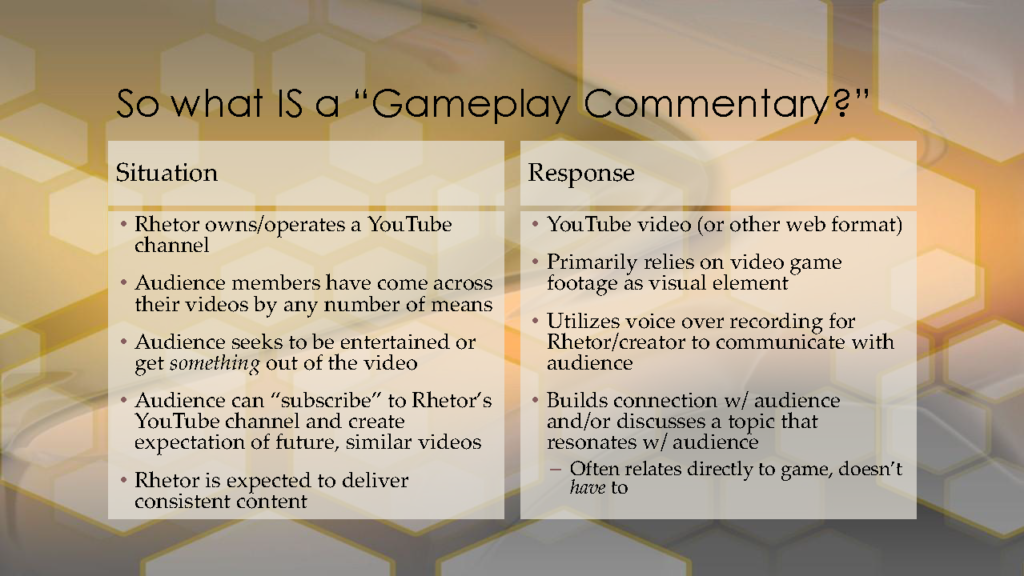
This expectation of future video releases and the subscription system somewhat resembles regular viewers of television shows or regular listeners of radio talk shows. The creators, or YouTubers, are put in a situation in which they’re expected to continue to deliver content – rhetorical artifacts – which establish or continue a personal connection with the audience, involve video games and utilize gameplay footage, discuss relevant topics, and entertain the viewer for five or so minutes at a time. The YouTubers, as rhetors, respond to this situation by creating videos which fit the expectation but also go an extra step to provide added production value via music, on-screen graphics, or direct viewer involvement to stand out from one another.
Gameplay commentaries and other video game-related videos on YouTube are a new, but ever-popular genre of content being created and delivered every hour on YouTube. This is a wide landscape of rhetoric – both in creation and delivery, and in consumption – and provides a lot more information to study and analyze how people communicate. It’s important to see the process behind these types of videos and understand their importance to the community in order for them to receive proper acceptance and understanding in rhetoric.
Gameplay videos are just the tip of the iceberg on YouTube, however. There are millions of videos of many different genres and styles on YouTube – all with their own nuances and characteristics.
References
- BBK Dragoon. (2012, April 23). Monday Night in the Pit | Hayabusa Sniping. BBKDRAGOON. Video retrieved from https://www.youtube.com/watch?v=xlh9MZaJigo
- BDoubleO100. (2014, October 17). Minecraft :: MY Redstone Tutorial 4U :: Mindcrack Server :: Episode 39. BdoubleO100. Video retrieved from https://www.youtube.com/watch?v=uQURoRvfPlU
- Montoya, Adam. (2010, July 15). Dealing with Stress. SeaNanners Gaming Channel. Video retrieved from https://www.youtube.com/watch?v=Z3B5u2ObnLs
- Panserchu. (2015, March 9). #70: I’m on a boat (World of Warcraft with IamChiib). Panserchu. Video retrieved from https://www.youtube.com/watch?v=jUWawRntCQI
- Tetra Ninja. (2014, February 21). Lightning Returns Final Fantasy XIII Walkthrough Part 17 – Vanille (Gameplay Let’s Play). Tetra Ninja. Video retrieved from https://www.youtube.com/watch?v=J2_hbjyZTQg
- Turtle Entertainment GmbH. (2015). Intel Extreme Masters World Championship 2015. ESL Gaming Network. Retrieved from http://en.intelextrememasters.com/season9/worldchampionship/

